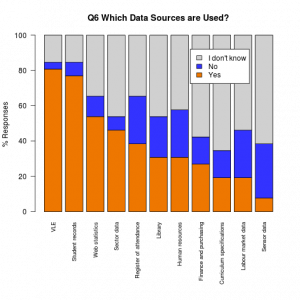Link: CETIS Analytics Series vol 1, No 9. A Brief History of Analytics (pdf)
Link: CETIS Analytics Series vol 1, No 9. A Brief History of Analytics (MS Word .docx)
The potential of analytics according to this definition is to help us to evaluate past actions and to estimate the potential of future actions, so to make better decisions and adopt more effective strategies as organisations or individuals. Analytics allows us to increase the degree to which our choices are based on evidence rather than myth, prejudice or anecdote.
Several factors are coming together at the moment to stimulate interest in making more use of analytics. One of these is the increased availability, detail, volume and variety of data from the near-ubiquitous use of ICT (Information and Communication Technology) throughout almost all facets of our lives. This aspect tends to be the focus of the news media but data alone is not enough to realise benefits from analytics. A less popularised factor driving effective exploitation of analytics is the rich array and maturity of techniques for data analysis; a skilled analyst now has many disciplines to draw inspiration from and many tools in their toolbox. Finally, the increased pressure on business and educational organisations to be more efficient and better at what they do adds the third leg to the stool: data, techniques, need.
This paper, one of the CETIS Analytics Series, is aimed at readers who wish to be introduced to the range of techniques that are being pieced together and labelled as Analytics. It does this by outlining some of the most important communities – each with their own origins, techniques, areas of limitation and typical question types – and suggests how they are contributing to the future, with special reference to the context of post-compulsory education.
The diversity and flexibility of some of the techniques lined up under the analytics flag is evidenced by the numerous different applications of analytics: financial markets, sports analytics, econometrics, product pricing and yield maximisation, fraud, crime detection, spam email filters, marketing, customer segmentation, organisational efficiency and even tracking the spread of infectious disease from web searches i. Behind these applications we can find the roots of analytics in the birth of statistics in the eighteenth century but since then different applications of statistics and IT have led to different communities of practice that now seem to be merging together. We see that Web Analytics pioneers are now expl oiting data from the “social web” by using Social Network Analysis and that the techniques of Information Visualisation are supporting interactive and exploratory forms of analysis rather than just the graphs in management reports. Subjects that some see a s old-hat such as Operational Research and others that are often perceived as futuristic such as Artificial Intelligence are each making contributions in surprising ways. Meanwhile, the education community has made its own contributions; Social Network Analysis and Artificial Intelligence have both emerged from academic research and we are now beginning to see sector – specific variants of analytics being put to work in the form of Educational Data Mining, Learning Analytics and bibliometrics.
Continue reading →

